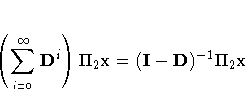Chapter Contents
Previous
Next
|
Chapter Contents |
Previous |
Next |
| The SIMLIN Procedure |
For models that have only first-order lags, the equation of the reduced form of the system can be rewritten

D is a matrix formed from the columns of
![]() 1 plus some columns of zeros, arranged in the order
in which the variables meet the lags.
The elements of
1 plus some columns of zeros, arranged in the order
in which the variables meet the lags.
The elements of ![]() 2 are called impact multipliers because
they show the immediate effect of changes in each exogenous variable
on the values of the endogenous variables.
This equation can be rewritten as
2 are called impact multipliers because
they show the immediate effect of changes in each exogenous variable
on the values of the endogenous variables.
This equation can be rewritten as

The matrix formed by the product D![]() 2
shows the effect of the exogenous variables one lag back;
the elements in this matrix are called interim multipliers and
are computed and printed when the INTERIM= option
is specified in the PROC SIMLIN statement.
The ith period interim multipliers are formed by
Di
2
shows the effect of the exogenous variables one lag back;
the elements in this matrix are called interim multipliers and
are computed and printed when the INTERIM= option
is specified in the PROC SIMLIN statement.
The ith period interim multipliers are formed by
Di![]() 2.
2.
The series can be expanded as

A permanent and constant setting of a value for x has the following cumulative effect:

The elements of
(I-D)-1![]() 2 are called the total multipliers.
Assuming that the sum converges and that (I-D) is
invertible, PROC SIMLIN computes the total multipliers when the TOTAL
option is specified in the PROC SIMLIN statement.
2 are called the total multipliers.
Assuming that the sum converges and that (I-D) is
invertible, PROC SIMLIN computes the total multipliers when the TOTAL
option is specified in the PROC SIMLIN statement.
|
Chapter Contents |
Previous |
Next |
Top |
Copyright © 1999 by SAS Institute Inc., Cary, NC, USA. All rights reserved.